Index
- Growing requirements
- Important growing parameters
- Light, with special reference to greenhouses
- Relative humidity
- Carbon dioxide in greenhouses
- Seed germination
- Planting
- Soils
- Trellising
- Greenhouse cucumbers
- Specific sensitivities
- Yields
- Harvesting
2.1 Growing cucumbers requirements and habits of the plant
The cucumber responds like a semitropical plant. It grows best under conditions of high temperature, humidity, and light intensity and with an uninterrupted supply of water and nutrients. Under favorable and stable environmental and nutritional conditions and when pests are under control, the plants grow rapidly and produce heavily. The main stem, laterals, and tendrils grow fast. They need frequent pruning to a single stem and training along vertical wires to maintain an optimal canopy that intercepts maximum light and allows sufficient air movement.
Under optimal conditions, more fruit may initially develop from the axil of 4 each leaf than can later be supported to full size, so fruit may need thinning. Plants allowed to bear too much fruit become exhausted, abort fruit, and fluctuate widely in productivity over time. Excessive plant vigor is indicated by: rapid growth, thick and brittle stems, large leaves, long tendrils, deep green foliage, profusion of fruit, and large, deep yellow flowers. On the other hand, cucumbers are very sensitive to unfavorable conditions, and the slightest stress affects their growth and productivity.
Because fruit develops only in newly produced leaf axils, major pruning may be needed to stimulate growth. The removal of entire weakened laterals is more effective than snipping back their tips.
2.2 Important growing cucumbers parameters
2.2.1 Temperature, general and with special reference to greenhouses
Air temperature is the main environmental component influencing vegetative growth, flower initiation, fruit growth, and fruit quality. Growth rate of the crop depends on the average 24-h temperature the higher the average air temperature the faster the growth. The larger the variation in day night air temperature, the taller the plant and the smaller the leaf size. Although maximum growth occurs at a day and night temperature of about 28°C, maximum fruit production is achieved with a night temperature of 19-20°C and a day temperature of 20-22°C. The recommended temperatures in Table 2.1 are therefore a compromise designed for sustained, high fruit productivity combined with moderate crop growth throughout the growing season.
During warm weather (i.e., late spring and early fall), reduce air temperature settings, especially during the night, by up to 2°C to encourage vegetative growth when it is retarded by heavy fruit load. This regime saves energy because a 24-h average can be ensured by the prevailing high temperatures and favorable light conditions.
Table 2.1: Recommended air temperatures for cucumber cropping
|
|
Low light (°C) |
High light (°C) |
With carbon dioxide (°C) |
|
Night minimum* |
19 |
20 |
20 |
|
Day minimum |
20 |
21 |
22 |
|
Ventilation |
26 |
26 |
28 |
*A minimum root temperature of 19°C is required, but 22-23°C is preferable.
The optimum daily average air temperature is 15-24°C (65-75°F). Optimum temperatures for growth are at night, about 18°C, and during the day, about 28°C accompanied by high light intensity.
To ensure satisfactory stand establishment, soil temperatures should be at least 15°C (60°F). The higher the soil temperature, the more rapidly seedlings emerge and the less vulnerable they are to insects and damping-off diseases.
At 15°C (60°F), 9 to 16 days are required for seedlings to emerge. At 21°C (70°F), only 5 to 6 days are required. Even after emergence, cucumbers remain sensitive to cold temperatures. In cold areas, seeds should always be planted late enough to avoid frosts. Exposure to cool conditions will slow growth even if temperatures remain above freezing. Slow-growing seedlings are vulnerable to flea beetles (whose chewing significantly reduces leaf area of young plants). Too high temperatures during flowering decrease pollen viability.
Cool and cloudy growing season may cause bitter fruit.
2.2.2 Light, with special reference to greenhouses
Plant growth depends on light. Plant matter is produced by the process of photosynthesis, which takes place only when light is absorbed by the chlorophyll (green pigment) in the green parts of the plant, mostly the leaves. However, do not underestimate the photosynthetic productivity of the cucumber fruit, which, because of its size and color, is a special case. In the process of photosynthesis, the energy of light fixes atmospheric carbon dioxide and water in the plant to produce such carbohydrates as sugars and starch.
Generally, the rate of photosynthesis relates to light intensity, but not proportionally. The importance of light becomes obvious in the winter, when it is in short supply. In the short, dull days of late fall, winter, and early spring, the low daily levels of radiant energy result in low levels of carbohydrate production.
Not only do the poor light conditions limit photosynthetic productivity, but also the limited carbohydrates produced during the day are largely expended by the respiring plant during the long night. The low supply of carbohydrates available in the plant during the winter seriously limits productivity, as evidenced by the profusion of aborted fruit. A fully grown crop benefits from any increase in natural light intensity, provided that the plants have sufficient water, nutrients, and carbon dioxide and that air temperature is not too high.
2.2.3 Relative humidity, with special reference to greenhouses
High relative humidity (RH) generally favors growth. However, reasonable growth can be achieved at medium or even low relative humidity. The crop can adjust to and withstand relative humidity from low to very high but reacts very sensitively to drastic and frequent variation in relative humidity. Its sensitivity to such variation is greatest when the crop is developed under conditions of high relative humidity.
Other disadvantages of cropping under conditions of high relative humidity include the increased risk of water condensing on the plants and the development of serious diseases. The resultant low transpiration rates are blamed for inadequate absorption and transport of certain nutrients, especially calcium to the leaf margins and fruit. At low relative humidity, irrigation becomes critical, because large quantities of water must be added to the growth medium without constantly flooding the roots and depriving them of oxygen.
Furthermore, low relative humidity favors the growth of powdery mildew and spider mites, which alone can justify installing and operating misting devices.
2.2.4 Carbon dioxide in greenhouses
In relatively high temperatures and light intensity, supplemental carbon dioxide applied at a concentration up to 400 ppm has proved economically useful. Regions with a moderate maritime climate, can more likely benefit from carbon dioxide applied in the summer only. But in regions with a continental climate, the need to ventilate the greenhouse actively throughout the hot summer renders the practice less economical. Apply carbon dioxide during the day or any part of the night when artificial light is supplied. It is economically feasible and highly advisable to use liquid carbon dioxide (carbon dioxide gas liquefied under pressure) because of its guaranteed purity and amenity to accurate concentration control. Liquid carbon dioxide is also preferred because burning natural gas or propane to generate carbon dioxide increases the risk of plant injury from gaseous pollutants, e.g. ethylene.
2.2.5 Seed germination
Seeds germinate and emerge in three days under optimum conditions. During this time seed coat remains tight.
Once cotyledons emerge, roots develop quickly.
Sunlight delivers photosynthates to true leaves and root system.
During the 1st week cotyledons integrity is very important, and if damaged, plants will set back.
Seedlings may recover but they will be weak and susceptible to stresses.
For proper germination, soil temperature must be above 15°C (60°F). If the soil is too cold and wet poor seedling emergence will take place.
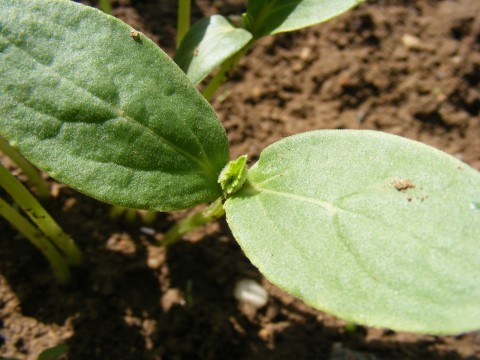
2.2.6 Planting
Cucumbers growth season is relatively short, lasting 55-60 days for field-grown varieties, and over 70 days for greenhouse varieties.
Planting dates
Cucumbers are almost always direct seeded. Like most cucurbits, they do not transplant well and transplant costs would be hard to recover. Planting depth is 2.5-4 cm (1-1.5 inches). Too deep delays emergence.
Pickling cucumbers have to be very precise on planting dates so that harvest will coincide with processor needs.
For early crop, container-grown transplants are planted when daily mean soil temperatures have reached 15°C (60°F) but most cucumbers are direct seeded. Early plantings should be protected from winds with hot caps or row covers. Growing on plastic mulch can also enhance earliness.
Spacing
Planting spacing depend on the growth method, variety and harvesting method.
Close spacing increases yields, provides more uniform maturity and reduces weed problems. It also results in shorter fruit with a lighter color.
On the other hand, high plant population requires more seeds and slightly higher fertilizer rates.
Table 2.2: Spacing and seeding parameters for open field cultivation
|
Hand- harvested |
|||||||
|
Consumption method |
Plant density (plants/ha) |
Distance between rows |
Distance within row |
Seeds mass |
|||
|
cm |
Feet |
cm |
Inch |
kg/ha |
lbs/acre |
||
|
Fresh (slicers) |
40-50,000 |
90-120 |
3-4 |
23-30 |
9-12 |
1.7 |
1.5 |
|
Pickles (processing) |
60-75,000 |
90-120 |
3-4 |
15-20 |
6-8 |
2.0-5.5 |
2-5 |
|
Machine- harvested |
|||||||
|
Pickles (processing) |
50-75,000 |
60-70 |
24-28 |
5-10 |
2-4 |
1.8-5.5 |
1.8-5 |
Greenhouse plant spacing should provide: 1-2.5/m2 or more per plant, depending on pruning and training system. Recommended density is 33,000 - 60,000 plants/ha.
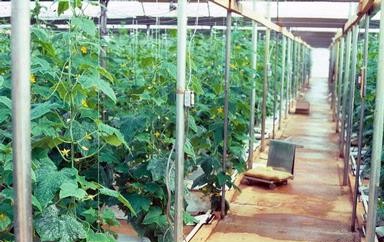
Figure 2.2: cucumber greenhouse with trellised plants
2.2.7 Soils
Cucumbers prefer light textured soils that are well drained, high in organic matter and have a pH of 6 - 6.8. Adapted to a wide-range of soils, but will produce early in sandy soils. Cucumbers are fairly tolerant to acid soils (down to pH 5.5).
Greenhouse cucumbers generally grow quite well in a wide range of soil pH (5.5-7.5), but a pH of 6.0-6.5 for mineral soils and a pH of 5.0-5.5 for organic soils are generally accepted as optimum.
When the pH is too low, add ground calcitic limestone, or an equal amount of dolomitic limestone when the magnesium level in the soil is low, to raise it to a desirable level.
Usually the pH in most greenhouse mineral soils is above the optimum pH range (6.0-6.5). A simple, though temporary, solution to a high pH problem is to add peat, without neutralizing its acidity with limestone. Peat also helps to maintain a good soil structure, but it must be added yearly to make up for loss through decomposition.
Soil preparation before field planting
- Soil fumigation aids in the control of weeds and soil-borne diseases. Fumigation alone may not provide satisfactory weed control under clear plastic.
- Black plastic mulching before field planting conserves moisture, increases soil temperature, and increases early and total yield. Plastic should be placed immediately over the fumigated soil. The soil must be moist when laying the plastic. Black plastic can be used without a herbicide.
- Plastic and fumigant should be applied on well prepared planting beds, 2-4 weeks before field planting.
- Fertilizer must be applied during bed preparation. At least 50% of the nitrogen (N) should be in the nitrate (NO3) form.
- Herbicides recommended for use on cucumbers may not provide satisfactory weed control when used under clear plastic mulch on non-fumigated soil.
- Foil and other reflective mulches can be used to repel aphids that transmit viruses in fall planted cucumbers.
- Direct seeding through the mulch is recommended for maximum virus protection. Fumigation will be necessary when there is a history of soilborne diseases in the field. Growers should consider drip irrigation with plastic mulch.
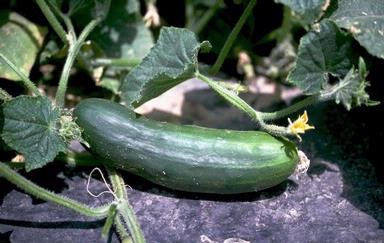
2.2.8 Trellising
Cucumber vines can be trained on trellises to save space and improve yield and fruit quality. But the high cost of trellising makes commercial production by this method uneconomical in most cases. Greenhouse cucumbers must be trellised, because the long fruit bend if they rest on the ground.
The major advantages of trellising a cucumber crop include:
- harvesting efficiency
- pest management efficiency
- straighter fruits
- uniform fruit color
- reduction of fruit loss due to soil diseases
- increased yield due to closer rows
- Reduced rate of crooked fruits makes trellising absolutely necessary for Oriental slicing cucumbers
Disadvantages include:
- extra cost of trellising materials
- labor to erect the system, dismantle it and training the vines
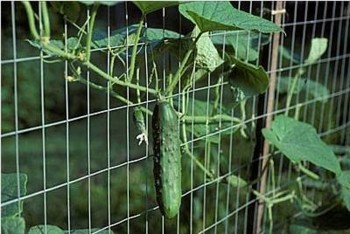
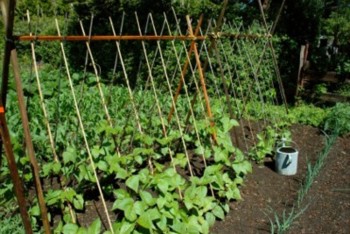
Figure 2.3: Different methods of trellising cucumber plants
2.2.9 Greenhouse cucumbers
Flowering habit and fruit set
All European greenhouse varieties produce fruit without pollination. They are gynoecious in flowering habit, and fruits develop without the need for pollination.
Cultural practices
Greenhouse cucumbers grow rapidly under optimum environmental conditions, and fruit production begins 60 - 70 days after seeding. For good production, a temperature range of 24 – 27 Co (75 - 80 Fo) during the day is desirable. While peak daytime temperatures of 29 - 25 Co (85-90 Fo) are tolerable, prolonged periods of high temperatures may adversely affect fruit quality. Night temperatures no lower than 18 Co (65 Fo) will allow a rapid growth rate and earliest fruit production.
Planting and plant growing cucumbers
Plantings of greenhouse cucumbers are ordinarily started from transplants, but direct-seeding in greenhouse beds may also be practical for late summer or early fall plantings, when the time from seeding to fruiting may not be as critical and prevailing temperatures are warm enough for good seed germination without having to heat the greenhouse.
Transplanting makes more efficient use of greenhouse space, because seed germination and early growth of plants can be confined to a smaller nursery area. Disadvantages to transplanting are the costs of containers and the labor costs of transplanting.
Spacing, training and pruning
The decision on the number of plants to be grown in a given area of greenhouse should be based upon expected light conditions during growth of the crop and also upon the method of pruning the plants. With good sunlight, each plant is allotted about 0.5 m2 (5 feet2) space. Nearly twice that much space may be needed with low light to avoid leaf overlapping and shading by adjacent plants.
Spacing between rows and plants within the row can vary with grower preference. Rows are often spaced 1.2 – 1.5 m (4 - 5 feet) apart, with plants 30 – 45 cm (12 - 18 inches) apart in the row.
Most growers prune their plants by the umbrella system. In this system, all lateral branches are removed as they develop until the plant reaches the overhead support wire. Fruits should not be allowed to develop on the lower 75 cm (30 inches) of the main stem to encourage the plant’s rapid vegetative development. Main-stem fruits above that point are allowed to develop at the base of each leaf.
More than one fruit may begin to develop at each node. Some growers thin these to a single vigorous fruit, but it may be more practical to leave all young fruits attached, because it has been observed that more than one may mature.
Fruit thinning
Overbearing can sometimes be a problem. To prevent the plants becoming exhausted and to improve fruit size, control the number of the fruit per plant through selective fruit thinning. This technique is powerful, so use it with great caution. The optimum number of fruits per plant varies with the cultivar and, even more, with the growing conditions. Although, limiting the number of fruits per plant invariably results in premium-priced large fruit, growers risk underestimating the crop's potential or failing to forecast good weather. They may decide to remove too many fruits and thus unnecessarily limit production. Fruit thinning is undoubtedly most useful in the hands of experienced growers who can use it to maximize their financial returns. Fruit to be pruned must be removed as soon as it can be handled, before it grows too large.
Irrigation
Maximum yields and fruit quality will be realized only if the plants receive adequate and timely moisture. Cucumber plants have shallow roots and require ample soil moisture at all stages of growth. When fruit begins setting and maturing, adequate moisture becomes especially critical.
The objective of watering is to maintain a fully adequate supply of water to the plant roots without soaking the soil to the extent that air cannot get to the roots. Do not wait until the plants start to wilt. A good practice is to dig into the soil and judge how much water remains before starting the next irrigation. Regular watering on the same day of the week is unwise. The needs of the plants change daily and seasonally. Water young plants planted in the greenhouse in January or February only once every 5-10 days and then only enough to wet 15-20 cm of the soil. Similar plants growing in June may need 5-10 fold as much water. Let the soil texture and structure determine how much water to add at each application. By examining the soil before watering and several hours thereafter, you can assess the effectiveness of the water application. Depending upon soil type and growth conditions, approximately 25–50 mm of water per week is needed to obtain high quality cucumbers. An irregular water supply, particularly during blossoming and fruit development, can detrimentally affect fruit quality and result in increased nubins or hooked fruit.
The pH of the water is also critical and may need to be adjusted. The target pH of the nutrient solution supplied to the plants should be between 5.5 and 6.0. Nitric, sulfuric, or phosphoric acid are recommended for reducing the pH if it is above 7. If the source water is alkaline due to high bicarbonate concentrations, the pH should be adjusted before the fertilizer salts are added to prevent precipitation. If it is necessary to raise the pH, potassium hydroxide is usually used.
Important: Irrigation timing should not interfere with pollination and should allow surfaces to dry before nightfall.
The drip irrigation system is better than most other conventional soil irrigation systems, because it can be used to control crop growth by regulating the supply of water and nutrients. The drip system also allows reduced relative humidity (RH) in the greenhouse, because not all the soil is irrigated and because the system is compatible with the use of white polyethylene film as a light reflecting mulch. In countries suffering from lack of good irrigation water the drip irrigation method has an important feature expressed by high water efficiency leading to very remarkable water savings.
Resources, including irrigation water and energy, are thus used more efficiently with this system. In most cases, use common in-line drippers with a standard flow of 2L/h and one dripper per plant.
However, because of the shallowness and extensiveness of the cucumber root system, consider a 4-L/h dripper, which usually results in more lateral movement of the irrigation water. Even better, provide two drippers (2 L/h each) per plant.
Micro-sprinklers, or misters, have also been tried at ground level along the row of plants, with favorable results on root growth, plant vigor, and productivity. However, such irrigation systems, if not properly managed, can easily lead to overwatering and then to disease outbreaks caused by excessive humidity and plant stem wetness. Another alternative is to use lay-flat polyethylene tubes (about 5 cm ID), with small holes spaced 10 cm apart. This system usually applies water to a much larger area than the drip system but does not raise the RH as much as a micro-sprinkler or
micro-mister system. Although fairly inexpensive, the lay-flat tube irrigation system has a short lifespan, which requires its frequent replacement. It is not a good choice for large greenhouses, because the water delivery rates vary significantly along the length of the line (i.e., not pressure compensating). Irrigate the crop up to four times a day, and use the irrigation system to apply fertilizer to the crop.
Fertilization
Greenhouse cucumbers grow quickly and should never be allowed to suffer from lack of water or nutrients. Advanced cucumber cultivation must supply the crop with optimal rates of nutrients throughout the growth cycle in the most efficient manner possible, and without degrading soil and water resources. The nutrient uptake rate by greenhouse cucumbers is very high. One study indicates that cucumbers may require in the range of 28 kg/ha (25 lbs/acre) of nitrogen, 5 kg/ha (5 lbs/acre) of phosphorus, and 40 kg/ha (35 lbs/acre) of potassium per week during peak fruit production. Fertilizer management practices need to assure that plant requirements are satisfied to achieve good yields of high-quality fruit. An important method that can assure that plant requirements are really satisfied is leaf analysis.
Leaf analysis
Visual diagnosis of disorders can be confused by symptoms induced by non-nutritional factors such as disease, pests and chemicals. Leaf analysis can be used to confirm a visual diagnosis. This involves chemical testing of leaves to establish whether specific nutrients are present in plant tissue at normal concentrations. This technique can be used to check the suitability of a fertilizer program and to anticipate the need for nutrient supplements. A disadvantage of leaf analysis is that it is slow, as most laboratories will take at least a week to process samples and report the results back to the grower. In many cases, laboratories do not interpret results or recommend how to remedy the situation.
Nutrigation™ (fertigation) (the application of fertilizer through the irrigation system) is a popular and efficient method of fertilizing field and greenhouse vegetables. Fertilizers are either dissolved in a large holding tank and the solution pumped to the crop, or they are mixed in concentrated stock solutions, which are then incorporated, using fertilizer injectors, into the irrigation water.
Several makes and models of fertilizer injectors are available at varying costs and offer varying degrees of fertigation control. A sophisticated fertilizer injection system capable of meeting the nutrient requirements of a series of crops automatically from the same set of stock solutions was developed may use an IBM-compatible computer to activate a series of dosimetric pumps at varying frequencies for the preprogrammed application of a desired concentration of individual nutrients. It also automatically adjusts the supply of water and nutrients to the crops in accordance with crop and environmental conditions. Introducing drip irrigation and fertigation has made it necessary to consider the fertilizer needs of a crop in terms of the concentration of fertilizer (and therefore the concentration of nutrients) in the irrigation water rather than on the basis of the cropped area.
Furthermore, the recommendations regarding the nutrient content of the fertigation solutions of drip irrigated crops are based mainly on the physiological responses and commercial
productivity of the crops. Most earlier recommendations for fertilizer application to traditionally grown crops in soil were based on estimates of nutrient removal by the crop.
Base fertilizers are not normally applied when drip irrigation is used, but peat and lime, may be still needed pre-planting to improve soil structure and adjust soil pH.
Two general examples of fertigation regimes are given, based on leaf analyses done during growth season, but this issue is further elaborated in chapter 3 (dealing with the entire aspect of cucumber mineral nutrition.
Table 2.3: Nutrigation™ schedule and rates for cucumber with N:K ratio = 1:2 *
|
Days after planting |
Daily nitrogen |
Daily potash |
Cumulative |
|||
|
nitrogen |
potash |
nitrogen |
potash |
|||
|
kg/ha |
Lbs/acre |
|||||
|
(preplant) |
|
|
28 |
50 |
25.0 |
45.0 |
|
0 - 14 |
0.9 |
1.8 |
42 |
84 |
37.6 |
75.2 |
|
15 - 63 |
1.5 |
3.0 |
124 |
220 |
110.3 |
196.6 |
|
64 - 77 |
0.7 |
1.4 |
135 |
243 |
120.1 |
216.6 |
Table 2.4: Nutrigation™ schedule and rates for cucumber with N:K ratio = 1:1 *
|
Days after planting |
Daily nitrogen |
Daily potash |
Cumulative |
|||
|
nitrogen |
potash |
nitrogen |
potash |
|||
|
kg/ha |
Lbs/acre |
|||||
|
(preplant) |
|
|
27 |
27 |
24.0 |
24.0 |
|
0 - 7 |
1.0 |
1.0 |
35 |
35 |
31.0 |
31.0 |
|
8 - 21 |
1.5 |
1.5 |
58 |
58 |
52.0 |
52.0 |
|
22 - 63 |
2.0 |
2.0 |
152 |
152 |
136.0 |
136.0 |
|
64 - 70 |
1.5 |
1.5 |
168 |
168 |
150.0 |
150.0 |
* Based on leaf analysis.
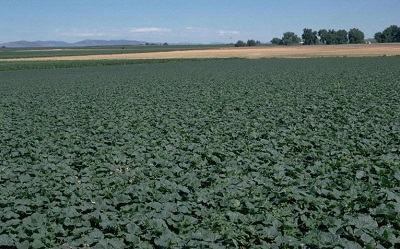
Figure 2.4: Nutrigation™ is a well-established method to increase cucumbers productivity.
Crop rotation
It is recommended not to rotate to crops in the same family during a 3-year cycle for most diseases, but 5 years must be maintained after Fusarium wilt incidence.
Cucumbers Phytophthora blight is the same as buckeye rot on tomatoes. All curucbits get it, although there are differences in susceptibility. Therefore, cucumbers should be rotated with crops other than peppers, eggplants, tomatoes, and other cucurbits.
2.2.10 Specific sensitivities
Cucumbers and other cucurbits have a number of specific sensitivities that may jeopardize yields and fruit quality. Among these sensitivities we can mention general salinity (high E.C. values), sensitivity to specific ions such as calcium, magnesium, sodium, chloride and perchlorate.
Salinity
Salinity damages may be caused by high E.C. ground water, irrigation water, soil or growth medium, and by excessive application of fertilizers.
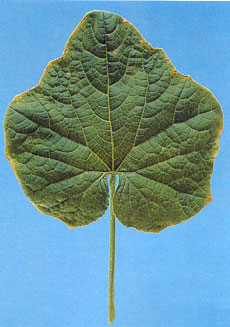
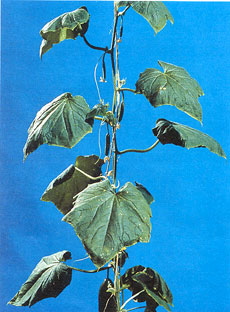
Figures 2.5 & 2.6: High salt or E.C.: Leaves appear dull and leathery. A narrow yellow border develops around the leaf margin
Plants grown under saline conditions are stunted and produce dark green, dull, leathery leaves that are prone to wilting (Figure 2.5). A narrow band of yellow necrotic tissue is often present on leaf edges (Figure 2.6). This can affect leaf expansion, causing a slight downward cupping of the leaf.
After a serious water stress, the oldest leaves may develop a uniform pale green chlorosis and small necrotic areas within the leaf. If water supply is maintained, leaves may only develop a band of pale green tissue around their edges. Plants are likely to wilt in warm weather.
Numerous studies have showed a linear decrease in the yields of cucumbers as the salt concentration of the irrigation water increased. The yield reduction was about 17% for a 1 mmho/cm increase in the E.C. (See Figures 2.7.& 2.8.)
Figure 2.7 clearly shows also that cucumber plants are sensitive to saline conditions. Salinity hinders the vegetative growth of the plants. Moreover, salinity severely reduces crop productivity as shown in Figure 2.8.
Figure 2.7: The effect of E.C. on relative growth rate of cucumber (cv. Dina) seedlings (Al-Harbi, 1995)
Figure 2.8: The effect of salinity on cucumber yield(Ayers, 1977)
Cultural treatments to counteract salinity effects are:
- Leach the soil or growing medium with fresh water until the excess fertilizer is removed.
- Adjust the fertilizer program to ensure that rates do not exceed crop needs.
- Use cultivars that are more salinity resistant.
- Apply abundant amounts of potassium fertilizer, other than potassium chloride, as potassium markedly enhances plants ability to cope with salinity stresses.
Chloride (Cl-) toxicity
Normal cucumber growth requires only small quantities of chloride similar to iron, but if the supply is plentiful more is taken up. Chloride toxicity can develop into a serious problem.
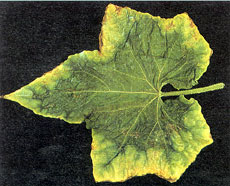
Figure 2.9: Chloride toxicity symptoms on cucumber leaf
Particular attention is required in recirculated hydroponic growth systems. Crop analysis showed that when sodium and chloride were added to the irrigation water, chloride was taken up in much greater quantities by the cucumber roots than sodium. The chloride anion markedly reduces plant vigor and tends to accumulate in the leaves margins, producing a band of pale green tissue around the leaf margin with some leaf-edge scorching and necrosis (tissue death), that stems from concentration rise up to 3% (!!!) (See Figure 2.9.) Such leaves are prone to premature leaf abscission, and reduced photosynthesis activity.
Due to the specific chloride sensitivity of cucumbers, it is highly recommended to avoid fertilizers containing chloride, such as potassium chloride (muriate of potash (KCl), or calcium chloride (CaCl2) in field grown cucumbers. Moreover, chloride-free fertilizers are an absolute prerequisite in hydroponic systems for best cucumber yields.
Perchlorate toxicity
Perchlorate anion (ClO4)- is present in mineral deposits of natural nitrates. Therefore, it is sometimes present in fertilizers produced from those deposits, like potassium nitrate produced in Chile. Perchlorate is a strong acid which decreases the activity of the enzyme RuDP (Ribulose Diphosphate Carboxylase).
When used for the cultivation of greenhouse vegetables it was proved that perchlorate at minute concentrations of 0.3% of the nutrient solution resulted in the “Bolblad” syndrome manifested by the following symptoms:
- Leaf curl and malformation developing into partial necrosis.
- Partial opening of the female flowers.
- Marked reduction in yields due to reduced fruit-set.
- Malformed cucumbers.
Glyphosate toxicity
Glyphosate is a very popular wide-range herbicide. When used near cucumber plants, minute amounts absorbed by the cucumber plant are enough to produce damages that include upwardcurling, pale green to yellow younger leaves and severe stunting. (See Figure 2.10.)
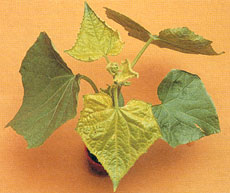
Figure 2.10: Glyphosate toxicity symptoms on cucumber leaves
2.2.11 Yields
Yields of cucumbers greatly vary according to varieties and growth conditions. The world average is 15 t/ha, while yields of 350 t/ha or more are obtained in modern greenhouses in Europe.
Beit Alpha varieties can yield: 250-450 t/ha and Dutch varieties yield 400 t/ha.
Where yields are 30-60 t/ha under poor cultivation conditions, they can reach 100-300 t/ha under optimal temperature, humidity, light intensity and pollination, achieved under glass).
2.2.12 Harvesting
Cucumber crop matures within 40 - 50 days and harvesting starts 45 - 55 days after planting.
Harvest during summer to early fall depending on planting time, and variety.
Unless an once-over mechanical harvester is being used, mainly for the pickling industry, fresh consumption cucumbers should be harvested at 2-4 day intervals, when the fruits have reached desired size, to avoid losses from oversized and over-mature fruit.
Important: Over mature cucumbers left on the vine inhibit new fruit set.
Pickling types are harvested when fruits are 5-7.5 cm (2-4 inches) long, and slicing types (for fresh market) - when fruits are dark green, firm, 15-20 cm (6-8 inches) long with a diameter of 4-5 cm (1½ - 2 inches).
Fresh-market cucumbers are ready for harvesting when they are about 6 to 10 inches long and 1.5 to 2.5 inches in diameter. The cucumber should be dark to medium green, without any signs of yellowing. On average, 58 to 65 days are required from seeding to maturity, depending on the cultivar and the growing conditions. Fresh-market cucumbers are harvested by hand. Because the individual fruits do not develop and mature consistently, the timing of maturity is not uniform within a field. As a result, fresh-market cucumbers typically are picked between 6 to 8 times over a 3-week period. In some situations, fresh-market cucumbers can be picked up to 12 to 15 times in a season. The number of pickings depends on when the seeds are planted and the supply and demand situation in the market. Price is an important factor in picking. Once prices for cucumbers fall below a certain level, it becomes uneconomical for growers to continue harvesting.
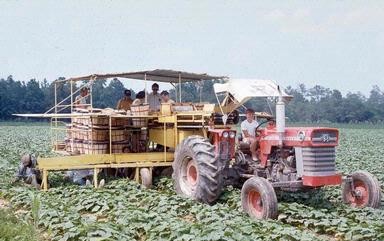
Pickling cucumbers are ready for harvesting when the ratio of length-to diameter ranges from 2.9 to 3.1. The cucumbers should be medium green, slightly lighter than fresh cucumbers, without any signs of yellowing. On average, it takes 55 to 65 days from seeding to maturity, depending on the cultivar and growing conditions.
Pickling cucumbers are either hand or machine harvested. Hand harvesting is common in areas where migrant labor is readily available. When harvested by hand, the field is typically picked 5 to 6 times. Pickling cucumbers must be harvested at 3- or 4-day intervals to prevent oversizing. If a machine is used for harvesting, however, the field is only picked once.
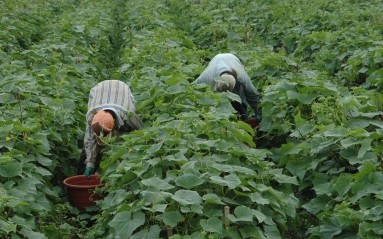
Need more information about growing cucumbers? You can always return to the cucumber fertilizer & cucumber crop guide table of contents or the cucumber growth stages



